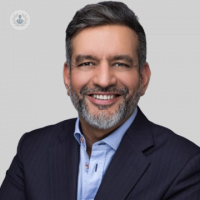PRP for rotator cuff injuries
Written in association with:Platelet-rich Plasma and other biological treatments like BMAC ( Bone Marrow Aspirate Concentrate) and MFAT ( Micro Fragmented Adipose Tissue) are modern treatments which have recently emerged as assistants as well as alternatives to surgery. Experienced consultant orthopaedic surgeon, Mr Ali Noorani explains how these treatments could help repair your rotator cuff injury.

What is PRP?
Our blood is made up of four main components; red blood cells, white blood cells, plasma and platelets. Platelets are what stop us from bleeding by clotting our blood, which they are able to do thanks to the growth factors and healing qualities present in them. They act as the body’s natural healing solution and are considerably more powerful than any available medication.
Plasma is the liquid that makes up over half of the bloods volume and carries the other elements around. Platelet-rich plasma is simply blood (plasma) that contains more platelets than normal. A higher concentration of platelets is achieved by extracting blood from healthy parts of the body and spinning it in a centrifuge (blood spinning). This causes the platelets and plasma to separate from the other components, before they are combined to make a platelet-rich substance full of healing powers. The PRP is then injected into the injured area which will now heal quicker thanks to the extra platelets.
What is BMAC and MFAT?
These are treatments using bone marrow or fatty tissue, which is also believed to have a high concentration of cells with healing qualities, from the body, before processing and cleaning it and then injecting it into the affected area. These cells remain in that area protecting it from further damage and aiding recovery.
How effective are these techniques for joint repair?
PRP, BMAC and MFAT treatments are favoured by an increasing number of doctors because they provoke natural healing. They don’t make anything happen that wasn’t already going to, but simply make the healing happen more powerfully and faster. There are no serious side effects to either procedure and the techniques are non-invasive.
Doctors and patients alike prefer these treatments to steroids as they are long term options. While steroids often provide instant relief, they don’t promote natural healing like PRP so problems are more likely to return in injured tissue.
How do rotator cuff injuries happen?
Like most injuries to the arm or shoulder, rotator cuff injuries occur when playing sport, lifting things or unfortunate accidents like falling. They also commonly happen as part of normal degeneration as part of the ageing process. The rotator cuff joint works in a similar way to a curtain hanging on a rail using hooks. If one or two hooks become detached from the rail, we can still use the curtain normally, but if too many are detached or if they are detached from the wrong end then the curtain will droop and eventually be impossible to use.
In the shoulder we have tendons instead of hooks, but the idea is the same, we can still use our arm and lift things if we’re missing a few tendons, but if we tear too many, we won’t be able to compensate.
How can PRP , BMAC and MFAT be used to repair rotator cuff injuries?
Depending on the severity of the injury, All of these techniques can either be used as an alternative to surgery, or to aid recovery after a procedure. When used as an alternative to surgery, all three methods have been proven to reduce pain, improve mobility and provoke tendon repair. However, for more severe cases, surgery may still be recommended. I.e the hooks need to be repaired if too many of them are injured.
The use of biological techniques have been known to speed post-operation recovery up considerably, so may be suggested by your doctor. It is said that surgery is like the first 10 metres of a 100 metre race, while time and rehabilitation take you to the finish line. PRP BMAC and MFAT treatments are not shortcuts to the finish line, you still need to rest well and take rehabilitation seriously. However, these treatments can enhance healing so they can make getting to the finish line quicker and more certain.
If you'd like to find out more about these techniques and whether they are viable for you, you can request an appointment with Mr Noorani here.


